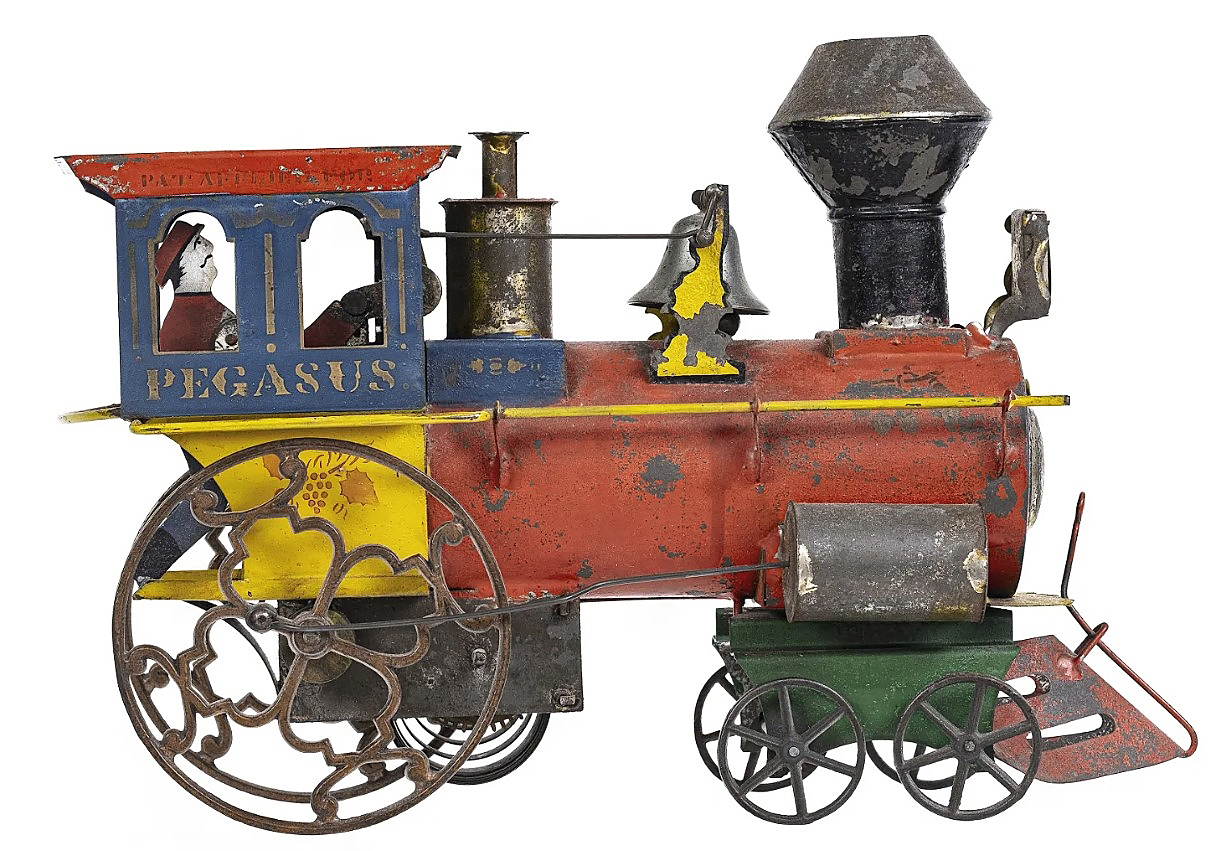
Illustrated in Bernard Barenholtz and Inez McClintock’s American Antique Toys, 1830-1900 (1980), this mechanical Pegasus Locomotive brought $78,000 ($35/45,000), a world record.
Review by Z.G. Burnett; Images Courtesy RSL Auction Company
WHITEHOUSE STATION, N.J. — The Crème de la Crème 2023 auction on August 5 at the RSL Auction Company was exactly that, with five-figure banks and toys topping the charts and 30 to 40 world records established out of 515 lots offered. Each of the top lots were rare examples of their respective designs. To put a fine point on it, the auction went “exceedingly well,” according to Leon Weiss, president of RSL. With 99.3 percent of the lots sold, the auction totaled $1,900,010.
There was a tie for first place between the auction’s two major categories, a bank and a toy that were both in pristine or mint condition. The bank was a Ding Dong Bell performing savings bank, made circa 1888 by the Weeden Manufacturing Company, New Bedford, Mass., which was in operation 1884-1952. One of three standard designs produced by Weeden at this time, the Ding Dong Bell was made of hand-painted sheet tin and moved through clockwork mechanisms. Not only did this bank come with the original box, but it was one of only three or four scarce examples that have ever been identified.
The toy was a mechanical Pegasus Locomotive, made by Ives, Blakeslee & Company, Bridgeport, Conn. (1868-1932), circa 1880. Described as “the finest mechanical trackless locomotive ever produced,” the authentic, unrestored Pegasus included a train conductor ringing its bell, a track light, a flaring smokestack and steam engine. Ex the Haradin family collection and the David Pressland toy collection, this locomotive also belonged to Bernard “Barney” Barenoltz, who featured it in the publication about his collection. Both of these lots established world records at $78,000.
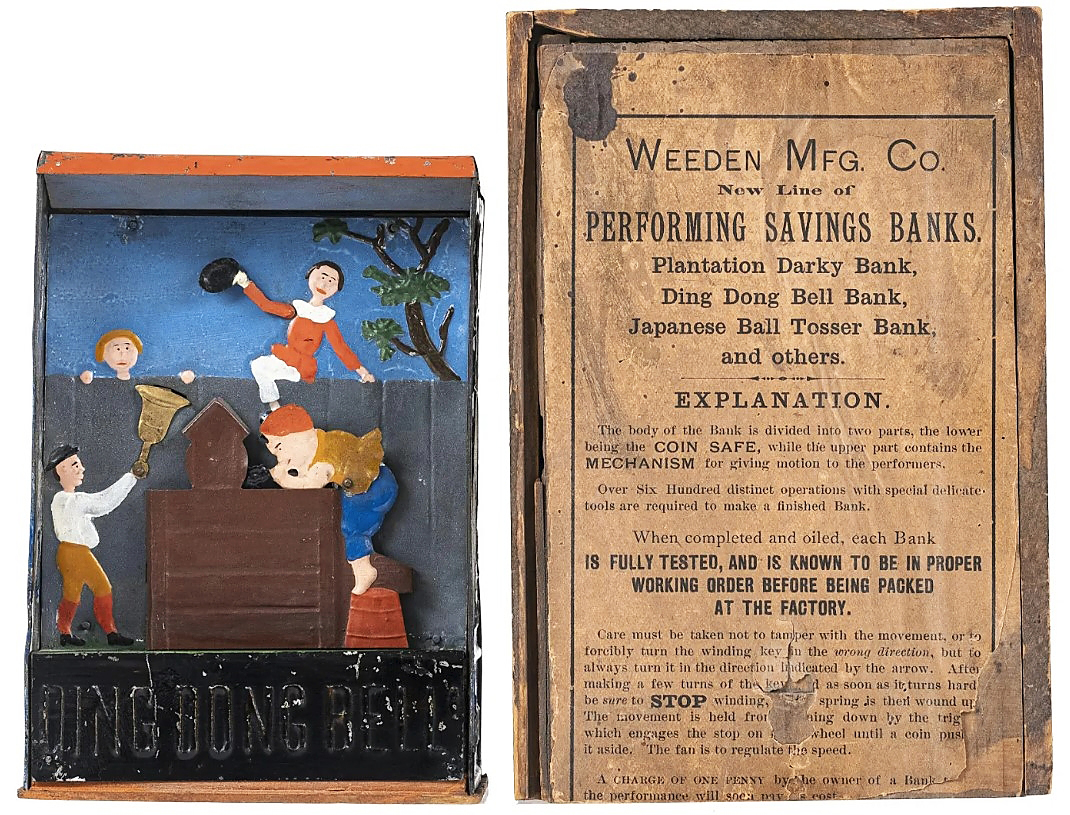
Ding Dong Bell performing savings bank, circa 1888, Weeden Manufacturing Company, from the Floyd Griffith collection, is one of only a handful known and established a world record at $78,000 ($60/80,000).
Slowly but surely, the cast iron “Pokey” the Turtle bank came in third place overall for $51,000. “Pokey” is a scarce bank from the Kilgore Manufacturing Company, Westerville, Ohio, due to a defect in its engineering. Meant to extend and retract its head when a larger coin was placed inside, sometimes this would damage the spring mechanism and the company discontinued the design after many complaints. This example had excellent paint and patina, and came from the Steckbeck collection.
Next was the “Jumping Rope Bank” from the J&E Stevens Company, Cromwell, Conn. (1843-1950), manufactured circa 1890-1900, described as “the most intricate and involved toy bank ever created.” Designed by James Bowen, the mechanical girl not only jumped rope but turned her head from side to side while her legs moved forwards and backwards. Due to its complexity, the bank was especially fragile, and few examples survived into the present day without repairs or damage; this bank endured in its original working condition and terrific shape. It was bid to $42,000.
Considered “one of the greatest treasures in the hobby,” a Merry-Go-Round cast iron bank from the Kyser and Rex Company, Frankford, Penn., was a “particularly stellar” example of this model. Kyser and Rex was only in operation from 1879 to 1899, closing when Alfred C. Rex began licensing production of its patented banks to other manufacturers. Operated by a hand crank, the carousel of five children riding exotic animals could be spun around after depositing a coin. It was bought at auction in New York City 40 years ago by Sy Schreckinger, ex the Al and Nora Hancock collection. This time, it sold for $39,000.
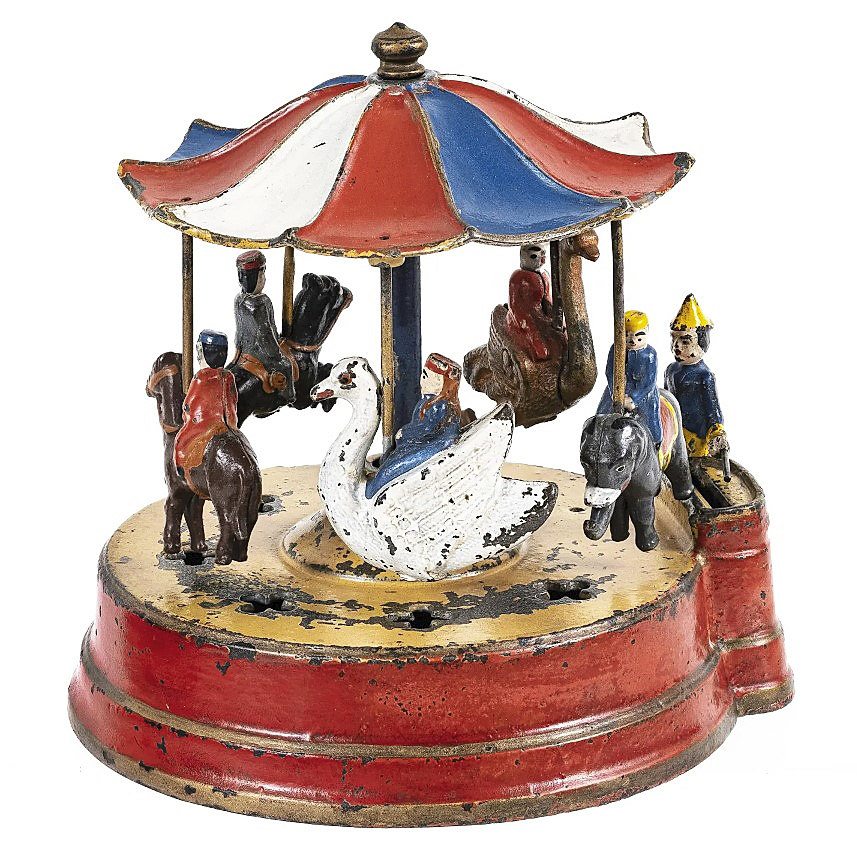
Merry-Go-Round mechanical bank, Keyser and Rex Company, came in just under its high estimate at $39,000 ($30/40,000).
Also achieving $39,000 and made by Keyser and Rex was “The Mikado,” circa 1880. Named for Gilbert and Sullivan’s hugely popular 1885 comic opera, the cast iron bank showed a traditionally dressed Chinese man, cast as more of a conjurer than the opera’s buffoonish politician-prince. Preserved without repair, the “game” of this bank ultimately results in the man tricking the depositor out of their coins. From the George and Millie McGuire collection, the bank was in its original condition.
Another bank from the Keyser and Rex Company to do well was a virtually mint Coin Registering Bank, illustrated in The Official Guide to Banks as plate 69, that set its own world record at $36,000. Measuring nickels and dimes, the bank only opened when it contained $5 total. These could be seen and recorded from the small window on the bank’s front. According to Weiss, this is believed to be the finest known example of this rare toy bank.
The next bank to set a record at $36,000 was a straight base Horse Race bank, made by the J&E Company and patented in 1871. One of the earliest toy banks ever made, it showed two sheet tin, mounted jockeys racing through a pair of gates as they circle the track. Found in an attic near Baltimore, the bank was fresh to market and in near mint condition.
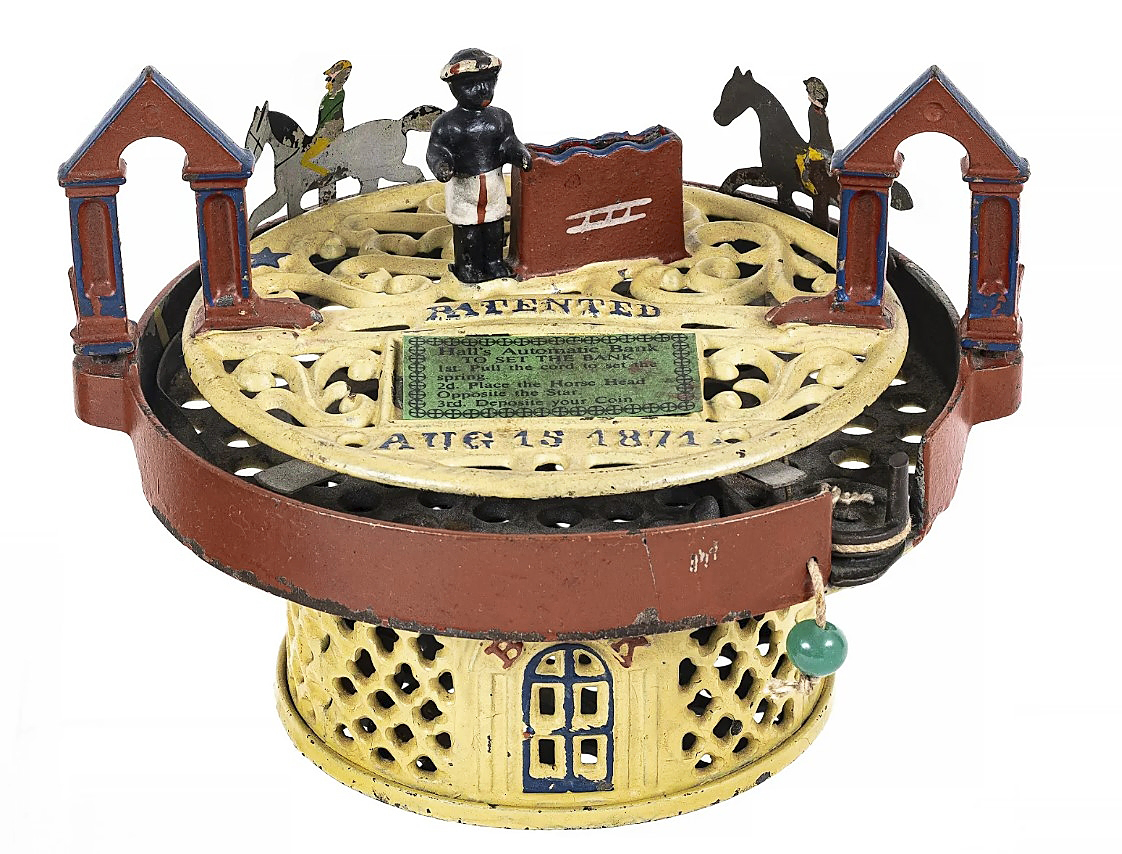
Another bank to set a world record at $36,000 ($30/40,000) was this Horse Race bank, one of the earliest toy banks, that was recently discovered in an attic and remarkably preserved.
Only two English toys in the top lots were made by the Williams Britains Company, London, both of which featured cyclists. Also achieving $36,000 was a velocipede, or more accurately a boneshaker, ridden by the puppet character Punch. There was a small clockwork mechanism in the stabilizing fulcrum that propelled the bicycle forward. The toy was in pristine condition and included its original box. Next was a cycling toy with a mustachioed rider named after acrobat and tightrope walker Charles Blondin (French, 1824-1897), which came from the Britains Archive Collection. This set its own record at $32,400. “Both of these bicycle toys should be seen as exceedingly scarce and important,” added Weiss.
From Ives, Blakeslee and Company and ex Haradin family collection was a mechanical, pipe-smoking and drinking Beermeister, which is the only known surviving example of this clockwork toy. When wound up, the man moves his head back and forth and puffs on his pipe, straddling a barrel that contains its internal mechanisms and bellows that cause the man to “exhale.” Presented in excellent, functioning condition, the Beermeister achieved $32,400.
The third lot to sell for $32,400 was another from the Haradin family collection, an American tin hose reel with decorative lions that they bought at a Rhode Island auction three decades ago. The toy was fresh to market at that time, and is exceedingly rare for its make and model. It was attributed either to the Merriam Manufacturing Company or the George Brown Company, Conn.; either way, it was in pristine condition having only been in two private collections in at least the past half century.
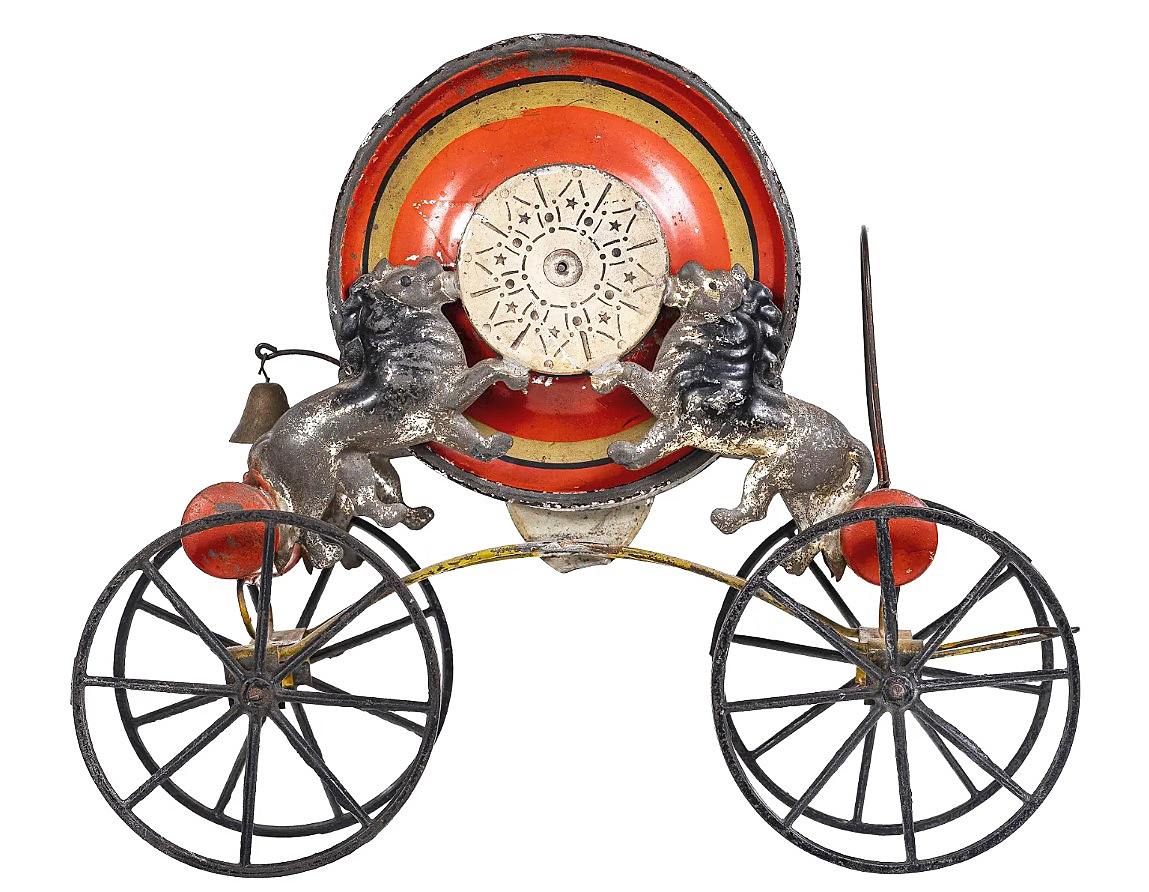
Rare, early American tin toy either from the Merriam Manufacturing Company or the George Brown Company, Conn., this circa 1875 hose reel rolled out $32,400 ($25/35,000).
Following this in price was another cast iron hose reel, this time accompanied by two firemen and drawn by two white horses. Made by the Pratt & Letchworth Company, Buffalo, N.Y. (founded 1854), the unusual but “absolutely extraordinary” toy included heart motifs on its reel and two rarely seen original pompier ladders. It was in near mint condition with crisp color from the Haradin family, and set yet another record at $31,500.
Three more top lots also achieved $31,500. The only steam model ship and the only German-made lot was an early 1910s example of a four-funnel liner, including lifeboats, anchors and a wheeled support trolley. It was in an outstanding state of preservation, meaning it had not been used often; when the mechanisms heat up, the paint peels off, yet much of this model’s paint was intact. Two cast iron mechanical banks followed in the catalog: a “Confectionery” bank from Kyser and Rex, and a “U.S.” bank from J&E Stevens Company.
Prices quoted with buyer’s premium as reported by the auction house. RSL Auction Company’s next online auction will occur on September 15. For information, 908-823-4049 or www.rslauctionco.com.




















